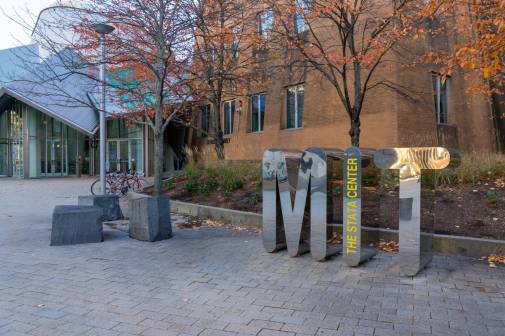Rutgers’ IT and finance chiefs lead by example in tackling IT-business challenges

On the surface, IT and finance can seem as different as any two departments at an institution, each with their own missions, stakeholders and operating rhythms. But as technology creeps into every crevice of higher ed operations, figuring out how to get IT and finance chiefs talking the same language about IT’s value across the institution has assumed a critical importance.
“The work higher ed is doing now is all about teamwork,” observes Betsey Reinitz, the director of EDUCAUSE’s Enterprise IT Program. “Over the past four years, being able to communicate with each other has become a pretty important issue to people in C-suite jobs.”
Reinitz would know. As part of her job, she coordinates an annual summit specifically devoted to improving relations between IT and finance leaders, and says the issue is both a priority and an ongoing challenge for many institutions.
Many IT and finance chiefs don’t talk as often as they should, she said in a recent interview with EdScoop. Getting the relationship right, she added, takes more than just establishing a good rapport. It requires a deeper understanding of how IT and business departments can benefit each other and the overall institution.
Among institutions showing how to master this delicate balance, Reinitz singles out Rutgers University in New Jersey, led by Chief Budget Officer Michael Gower — who is also the university’s treasurer — and CIO Michele Norin.
EdScoop spoke with both executives about what’s behind a collaborative approach that has eluded other schools, and how they turned a challenging situation into an opportunity to modernize Rutgers’ IT infrastructure.
Those challenges largely began in 2013 when the University of Medicine and Dentistry of New Jersey folded seven of its eight schools into Rutgers University, resulting in the largest merger in higher ed history and catapulted Rutgers into one of the top research institutions in the country. Rutgers now has an enrollment of more than 66,000 students.
In With the New
When Michele Norin landed her job at Rutgers in late 2015, the merger was in full swing and things were very much in flux. It was a baptism by fire that began when she joined Gower and the president’s cabinet for a two-day retreat where they walked through the current set of challenges, priorities and missions they would be tackling during the next three to five years.
“Each of the priorities we covered were specific to IT, and were also aligned with the core of our mission or some other oriented business or operational need that we need to focus on,” Norin said. “We’ve been vetting them as we go through.”
The heart of Rutgers’ long-range IT initiatives is perhaps its multi-year ERP implementation that is phasing out older legacy systems and replacing them with cloud-based services, allowing the school to “get out of the business of running the boxes,” as Gower put it, and pursue a more aggressive technology strategy that’s less focused on maintenance. “It’s a typical ERP implementation planning exercise,” Norin explained, “but with a cloud outcome for the product.”
Already, Gower and Norin have overseen the shutdown and cloud migration of two general ledger systems, two financial systems and one of its two HR payroll systems. The next wave will see the remaining payroll system move into the cloud and then, in a few years time, two student service systems.
All that’s in addition to the 200 separate email systems that have already been consolidated into a single cloud solution at a time when other projects and challenges have consumed much of Gower and Norin’s attention, such as adding more immersive, interactive technology to classrooms and increasing capacity and throughput for high-level research computing.
“We can delegate very well and still be fully engaged,” Gower told EdScoop.
To help create these priorities, Gower and Norin meet at least once a week — their offices are conveniently close — and they regularly liaise with a larger core group of senior-level colleagues responsible for academic affairs, research, human resources, facilities operations and risk management. Gower and Norin aren’t just setting and working on their own policy, but responding to others’ needs as well. “When something ends up on someone else’s priority list, we engage in figuring out how to support or to enable that,” Gower said.
A big part of what has enabled their laser-like focus on their priorities is strong top-level leadership, which Gower says is unusual, but most welcome. “Our president is very tech savvy, almost dangerously so,” he joked. “He just kind of loves this stuff so there’s lots of support — the kind you don’t typically get from the president at most institutions.”
“With all the initiatives we have in motion right now, we don’t have a choice but to work well together,” Norin said of her relationship with her finance colleagues. “And talking a lot and staying in sync is one way we approach it.”
Moving to Sustainability
The shift to cloud-based services also coincides with a large strategic planning effort centered on beefing up network infrastructure across the whole institution. It’s a move that Gower says requires them to reassess financing strategies that will see them move away from large, one-time capital expenditures every few years to a model that increasingly relies on ongoing operational expenses.
“Much of what we have going on right now is in project mode,” Gower said. “In each of these cases, we tried to do the estimate and either get the money or the authorization set aside, and then build the residual into the operating budget.”
His long term plan, however — which will begin with next year’s budget — is to use financing techniques to bake costs for services such as email, their ERP systems and other projects right into the operational budget, eliminating the need for periodic spikes of cash to fund projects that could continue into perpetuity.
At Rutgers, projects of the size and scope Gower and Norin handle are never siloed affairs; rather, the expectation is that more than one department will be working in collaboration.
In addition to the strong informal communication between teams, there is also a standardized process for leading any given project that sees department heads such as Gower and Norin assume formal positions as co-executive sponsors. The protocol requires the two share accountability and leadership, and report to the president and the board jointly.
“We make these decisions together,” Norin said. “When I say ‘we,’ it’s the institutional ‘we,’ the leadership ‘we.’ Whether I bring it up or not, when we decide to pursue something then the financial office, which is Mike’s area, helps figure out what’s the funding model for it, both upfront and then from a sustainability track.”
For Norin, the knowledge that her team’s work is a piece of a larger puzzle helps keep them focused.
“We figure out what we want to do and then how to do it,” she said. “Each of our respective areas has to plug into different parts of the process to figure out the implementation and the maintenance. We have to work on these initiatives together. It takes having each respective area play its part to make it a reality.”




